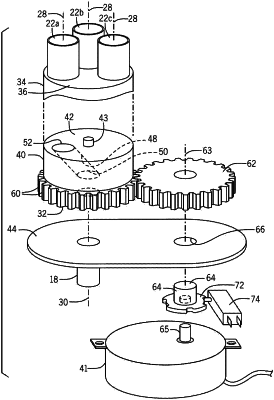| CPC F16K 11/0856 (2013.01) [A47L 15/4221 (2013.01); A47L 15/4472 (2013.01); D06F 34/08 (2020.02); D06F 39/083 (2013.01); F16K 11/074 (2013.01); F16K 31/04 (2013.01)] | 19 Claims |

|
1. An appliance diverter water valve for pumping water having filamentous contaminants, the diverter water valve comprising:
a housing defining an enclosed volume and having:
an inlet-side wall with an inlet channel for receiving water and aligned along an inlet axis;
an outlet-side wall with multiple outlets extending from the housing and providing multiple outlet channels aligned along axes parallel to the inlet axis;
a spool positioned in the housing between the inlet channel and the multiple outlet channels to rotate about the inlet axis, the spool having:
a spool body with a spool inlet end and a spool outlet end;
a tubular spool channel having a first end at the spool inlet end aligned with a proximate end of the inlet channel and a second end at the spool outlet end that is aligned with individual proximate ends of the multiple outlets as the spool rotates;
wherein the spool inlet end is proximate to and biased away from the housing inlet-side wall to provide an engagement between the spool outlet end and the housing outlet-side wall;
an electric motor operating to rotate the spool; and
a position sensor distinguishing a position of the second end of the spool channel alignment with individual proximate ends of the multiple outlet channels;
wherein the spool channel when aligned with a proximate end of a given outlet channel of the multiple outlet channels provides inner channel walls that are substantially continuous with inner walls of the inlet channel and inner channel walls of the given outlet channel.
|
|
18. A method of washing items producing filamentous contaminants comprising the steps of:
(1) placing the items in a wash chamber;
(2) pumping water out of the wash chamber through a diverter valve of a type having:
(a) a housing defining an enclosed volume and having an inlet channel for receiving water and aligned along an inlet axis and having multiple outlets extending from a wall of the housing and providing multiple outlet channels aligned along axes parallel to the inlet axis;
(b) a spool positioned in the housing between the inlet channel and the multiple outlet channels to rotate about the inlet axis, the spool having a tubular spool channel having a first end aligned with a proximate end of the inlet channel and a second end aligned with individual proximate ends of the multiple outlets as the spool rotates;
(c) an electric motor operating to rotate the spool;
(d) a position sensor distinguishing a position of the second end of the spool channel alignment with individual proximate ends of the multiple outlet channels;
wherein the spool channel when aligned with a proximate end of a given outlet channel of the multiple outlet channels provides inner channel walls that are substantially continuous with inner walls of the inlet channel and inner channel walls of the given outlet channel; and
(3) operating the diverter valve to change a path of water from the wash chamber between (i) returning directly to the wash chamber during a recirculating operational state defining a recirculating flow path in which water from the wash chamber is delivered through the diverter valve and an outlet pipe that connects the diverter valve to the wash chamber, wherein the outlet pipe includes an inlet end that is connected to and receives the water from the diverter valve and an outlet end that delivers the water into the wash chamber during the recirculating operational state, (ii) flowing through an additive chamber and then returning to the wash chamber, or (iii) diverting away from the wash chamber and exiting the appliance.
|